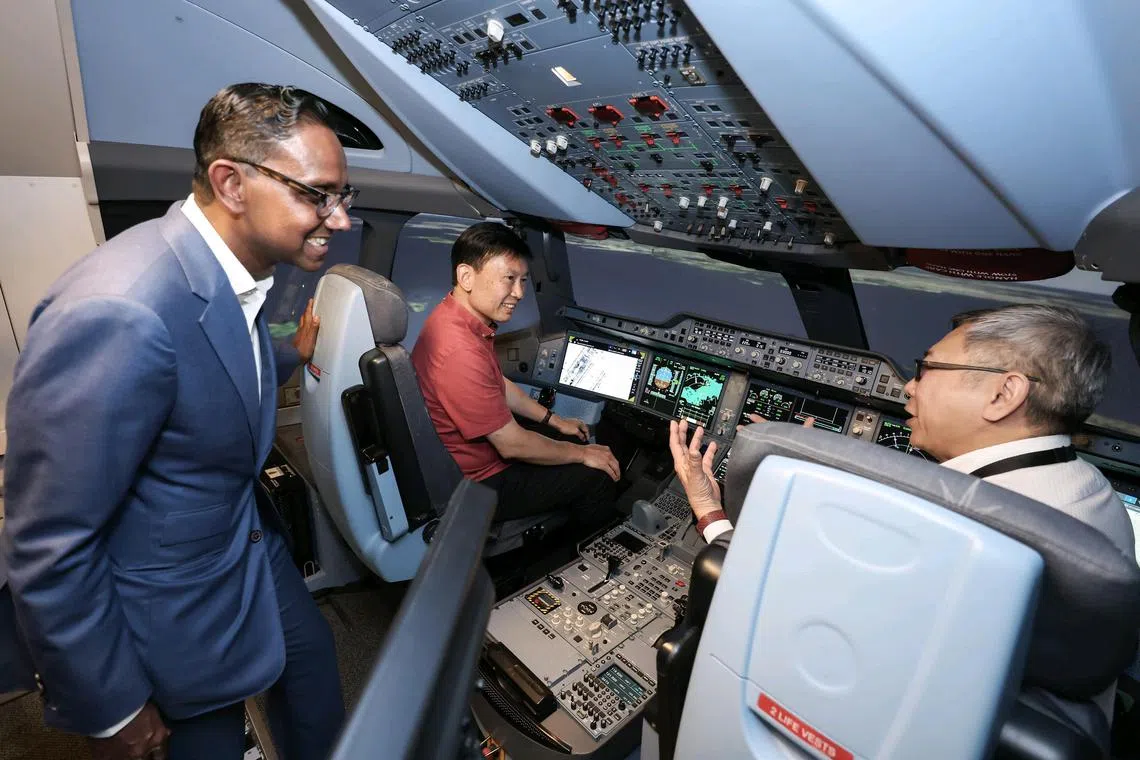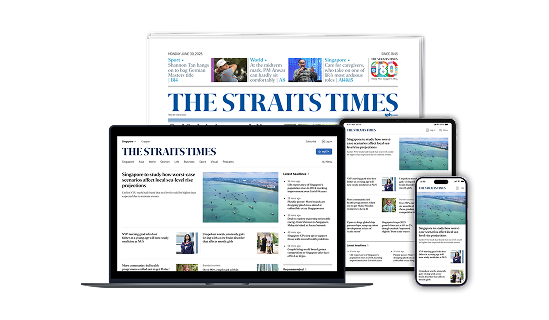S’pore’s aviation sector remains ‘bright spot’, employs 36,000 workers: Chee Hong Tat
Sign up now: Get ST's newsletters delivered to your inbox

Transport Minister Chee Hong Tat viewing an A350 simulation training pod at the Airbus Asia Training Centre, during his tour of the Airbus Singapore Campus in Seletar Aerospace Park on May 7.
ST PHOTO: BRIAN TEO
Follow topic:
SINGAPORE – Singapore’s aviation industry, which now employs about 36,000 workers, remains a “bright spot” amid a turbulent and uncertain global environment, Transport Minister Chee Hong Tat said on May 7.
This means Singapore’s aviation workforce has crossed levels recorded before the Covid-19 pandemic, when the sector employed 35,000 workers.
In recent years, employment figures in the aviation workforce have been creeping back up to 2019 levels
Mr Chee said key players in the industry, including national carrier Singapore Airlines (SIA), operator Changi Airport Group (CAG) and ground handler Sats, are continuing to hire for various roles and looking to expand.
He was speaking to reporters during a tour of the Airbus Singapore Campus in Seletar Aerospace Park.
Mr Chee said the aviation, maritime, supply chain and logistics industries are among those with the potential for further growth.
Ahead of the start of construction on Changi Airport Terminal 5
Noting that there are many things that could be done in the meantime, he said the nation aims to expand its aviation city links from the current 170 to 200 for better flight connectivity.
Mr Chee also said the authorities will work closely with key industry partners such as SIA to see how to support the airline’s growth, as well as Sats, to improve its competitiveness in Singapore and beyond.
On developing the aviation workforce, he noted that technology – including automation and digitalisation – can help to improve the productivity of workers and increase the efficiency of workflows.
Mr Chee added that digitalisation will require the redesigning of jobs, but he acknowledged that this is necessary to better retain older workers amid an ageing workforce, so that they can continue working in less physically demanding conditions.
At the same time, he said the growth opportunities from T5 and the expansion of the air cargo industry here will help to create more job opportunities, which could in turn benefit young people in Singapore.
Mr Chee cited figures released by CAG in April, which showed passenger traffic at Changi Airport from April 2024 to March reaching an all-time high of 68.4 million
The airport also handled two million tonnes of air cargo over the past year, up 11 per cent from the year before.
Mr Chee added that the development of the upcoming Changi East Industrial Zone
In the midst of the turbulence from trade wars and increasing global demand for talent, Mr Chee said, Singapore will have to play to its strengths, and trust will have a higher premium for the nation in an uncertain environment.
“We do have a trusted brand name. Industry partners and global investors know that when they come to Singapore, there is stability, and they are able to make long-term plans,” he added.
Calling on Singaporeans not to be overly pessimistic about the challenges in the new global environment, Mr Chee said: “We do have agency. We do have value that we can bring to the table – building on our strengths, our ability to plan long term, our pro-business and stable environment, our trusted brand name, and, importantly, our strong tripartite partnership.”
This refers to the partnership between the Government, employers and unions.
Mr Chee was asked whether Chinese carriers may turn to Singapore as a hub for aerospace maintenance, repair and overhaul services against the backdrop of the US tariffs.
He said it was important for Singapore to keep an open mind to new opportunities, but it was “a little bit too early” to comment on specific areas.
But he noted that the aviation industry should be ready to seize opportunities that may arise, by strengthening partnerships, deploying technology for better efficiency and upskilling workers for new jobs.
During the tour of the Airbus Singapore Campus, Mr Chee was introduced to the French plane-maker’s digital technologies and methods to measure the emotional responses of trainee pilots.
He also launched a display of a decommissioned Airbus helicopter outside the training centre within the campus. The helicopter, operated by the German armed forces, was later used for technician training.
Despite the global economic uncertainty, Mr Anand Stanley, president of Airbus Asia-Pacific, remains optimistic, noting that long-term economic forecasts for the Asia-Pacific region remain strong.
He attributed the potential for air travel growth to the fact that many people in the region are still not used to flying as a primary transport mode and the long distances between multiple islands within the Asia-Pacific.


